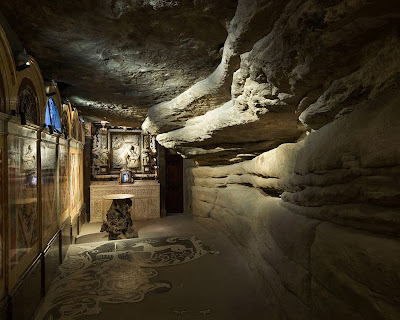As this post is being published, long-time Bridges prayer companion Sr. Mary Funge, sh, has entered hospice care near the end of a life filled with service and love. Tom Simon, who edited the Bridges newsletter for many years, brought to my attention this article written in 2011 by Sr. Mary about her pilgrimage to Manresa in the late 1990s. Enjoy, and say a prayer for her.

A Trip to Manresa
About 15 years ago I was asked to accompany one of our young sisters on her 30-day retreat in Vich, Spain. She was scheduled to go with a group of young Claretian novices and our Helper authorities thought it would be helpful for her to have another woman religious accompanying her. I did not take long to reply in the positive and decided to enter into the retreat while with the group. We stayed at the Claretian house in Vich where the body of their founder, Anthony Claret, lies in state in the chapel.
Vich is a small, bustling, hilly town in Catalonian Spain. We were near a river and there were many lovely parks. I was soon to learn about the spirit of Catalonia. In the village square fireworks went off one night in celebration of a feast and it was evident that the Catalonians wanted to be separate from Spain. This apparently is a longstanding political dilemma. And I soon found out that Manresa, about five miles south of Vich, is not only also in Catalonia but at its very center. The famous beautiful Montserrat is a few miles south of Manresa. All are situated in the North-east of Spain, not far from the coast and the well-known city of Barcelona.
Yes, Manresa was not far from Vich, and when my retreat director suggested that I consider making a pilgrimage during the second week of the Exercises, I decided to travel to the cave of Manresa where Ignatius had spent so much time in prayer and penance and had written what was to become the Exercises of St. Ignatius.
My trip took place during the early days of the second week of the Exercises and I remember centering on Jesus as a twelve-year-old going up to Jerusalem and the events that followed when He stayed behind in the temple. It turned out to be a really fitting contemplation for the day that followed.
As the bus pulled into the town of Manresa I was struck by the very hilly landscape. I felt myself surrounded by grey rock. The bus left me off in the center of a small business section where the stone buildings bore the appearance of many centuries. I soon spotted the River Cardoner down a hill and I headed in that direction.
As I remember, there were two churches nearby and I entered what turned out to be the large parish church first. Here I saw the Mass schedule on the door. It was in the middle of the day and, as it was still early morning, I decided to head down along the river where I could see other buildings, including the church where the famous cave is situated. I settled into the small chapel formed by the cave and spent the rest of the morning in prayer. There was a quiet, reverent atmosphere as people came to pray. It was a special time of being with Ignatius as you pictured his ardent presence praying in that very spot. His time in Manresa was marked by intense prayer and inspiration, as well as suffering.
James Brodrick, S.J. in his book, “St. Ignatius Loyola – The Pilgrim Years, 1491 – 1538” gives a description of Ignatius’ time in Manresa, pp. 96-97:
In the year 1595 and again in 1606, an ecclesiastical court was set up in Manresa (as in several other places) to examine witnesses on oath with a view to the canonization of Ignatius….By that time the Bishop of Vich, ordinary of Manresa, had built a little chapel above the Cave and it had become a place of pilgrimage and popular devotion. The tradition is therefore completely sound, but not so some of the deductions drawn from it, such as a widespread notion that Inigo lived under the rock in the fashion of an anchorite and wrote down most of his holy reflections. That was not the case. We know that he felt deeply the attraction of solitude, of being alone with the Alone, but he did not shut himself away as a hermit, but lived in the midst at Manresa, at first in the Hospital of the sick and poor, then, when ill and exhausted physically, in the houses of generous people who counted it a privilege to nurse him, and finally in a cell put at his disposal in their convent by the more than kindly Dominican Fathers. Both Hospital and Convent were wiped off the face of the earth by the 1936-1939 revolutionaries…but the Cave and the massive buildings erected around it in the nineteenth century, they left alone.
After attending Mass at the parish church, I toured the town taking in the atmosphere of this famous, small town. People gave friendly nods but, knowing just a few words in Spanish, my exchanges were strictly smiles. I soon thought that it would be a good idea to return to Vich as the day was moving on. So, I figured that I would wait for the bus to return on the same street where I had alighted. And so I waited – and waited.
After considerable time, I motioned to a friendly boy, about 12 years old, and managed to convey my dilemma. After failure to completely understand each other, he motioned to follow him. He entered a type of apartment house and we climbed up to the second floor. After knocking on a door, a gentleman, who spoke English, appeared. He explained that the return bus came in at a completely different road and gave me the directions. There I did find the bus and made my short trip safe and sound back to Vich.
I thanked my 12-year old boy, who stayed at my side until I was safely aboard the bus and was struck by the coincidence of being lost and also helped by a young boy. I knew that the Lord and Ignatius were guiding me in a very special way. I would highly recommend a visit to Manresa but also, study well your mode of travel and take some lessons in Spanish beforehand. I might add that this was a great prelude to my trip to Montserrat, where our retreat concluded some weeks later.
— Mary Funge, sh
